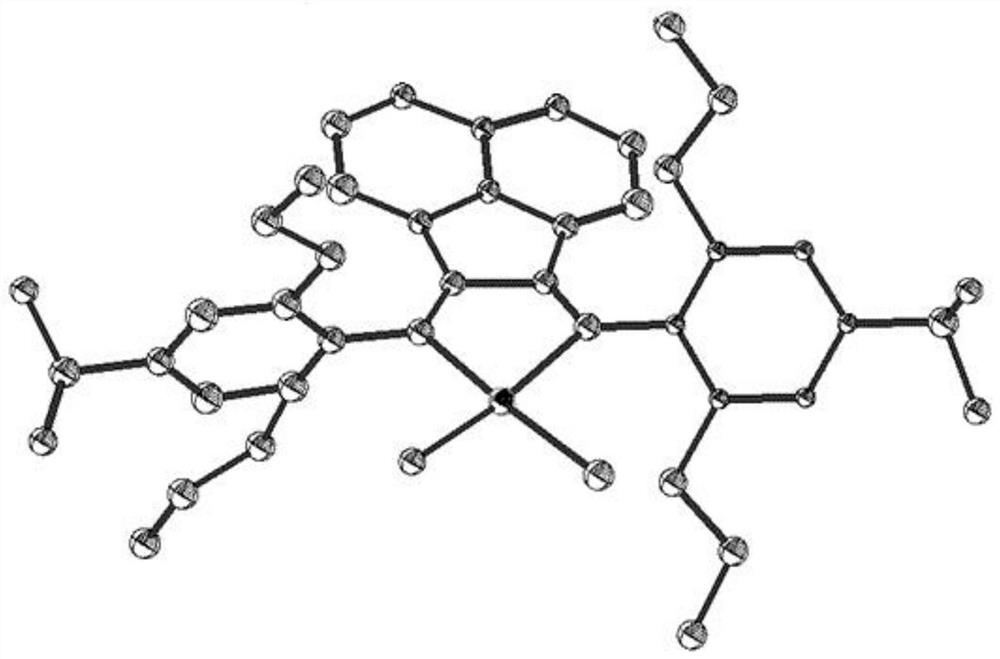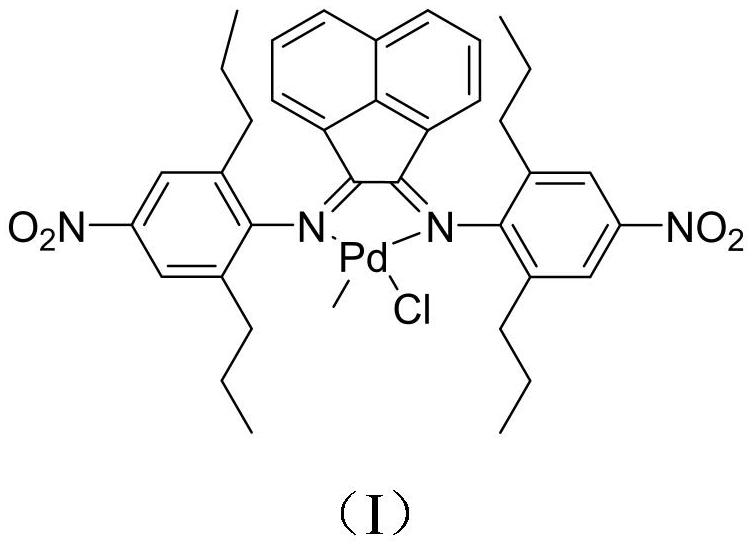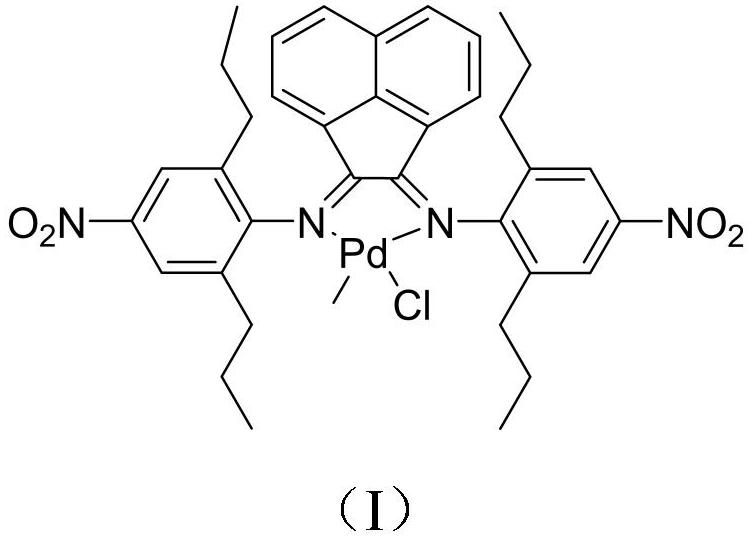Complex for catalyzing polymerization of 4-methyl-1-pentene and preparation method thereof
A technology of complexes and trimethylaluminum, applied in the direction of palladium organic compounds, platinum group organic compounds, chemical instruments and methods, etc., can solve the problem of deactivation of active centers, high manufacturing costs, and inability to catalyze the copolymerization of olefins and polar monomers and other problems, to achieve the effect of enhancing electrophilicity and improving catalytic activity
- Summary
- Abstract
- Description
- Claims
- Application Information
AI Technical Summary
Problems solved by technology
Method used
Image
Examples
Embodiment 1
[0033] The synthesis method of diimine ligand is as follows.
[0034] Under nitrogen atmosphere and room temperature, add 20mL of toluene, 2,6-dipropyl-4-nitroaniline (12mmol) in sequence to a 100mL branch bottle, and then slowly add 12mL of trimethylaluminum (1.0M, 12mmol) ; The reaction temperature was raised to 110° C., and after 2 hours of reaction, the reaction temperature was lowered to room temperature, and then acenaphthylquinone (5 mmol) was added; at this time, the reaction system changed from colorless to deep red, and released a large amount of heat; at 110° C. Continue to react for 6 hours, then lower the temperature to 0°C, and terminate the reaction system with 5% sodium hydroxide ice-water solution; extract the organic phase with ethyl acetate, and then use anhydrous MgSO 4 Dry and spin the solvent under reduced pressure to obtain an orange oil; the product is separated through a silica gel column, and the eluent (petroleum ether: ethyl acetate = 15:1); recryst...
Embodiment 2
[0036] The synthesis method of diimine palladium complex is as follows.
[0037] Under the protection of nitrogen, add diimine ligand (0.5mmol), (COD)PdMeCl (0.6mmol) and dichloromethane 20mL respectively in the Schlenk bottle with a branch, stir the reaction at room temperature for 12 hours, and then The solvent was evaporated under reduced pressure to about 5ml, and 20ml of n-hexane was added, at which time a large amount of precipitation occurred. Filtered with G4 filter ball, the precipitate was washed with 3×10mL n-hexane, and then vacuum-dried to obtain a yellow solid powder diimide palladium complex with a yield of 69.7%
Embodiment 3
[0039] This embodiment provides a poly(4-methyl-1-pentene), the preparation method of which is as follows.
[0040] All the glass instruments and magnets used for stirring were dried in an oven (120°C), and all polymerization experiments were carried out under anhydrous and oxygen-free conditions. Under continuous vacuuming, bake a 250mL branched-mouthed round-bottom flask under an infrared lamp at 150°C for more than 1 hour to remove all moisture and air; replace it with nitrogen twice and then fill it with nitrogen to normal pressure; keep the water bath to 0 ℃, add metered chlorobenzene, stir and dissolve, inject 2M monomer and 10 μmol diimide palladium complex dissolved in 2mL dichloromethane; stop the reaction after 4 hours of polymerization, and use Et 3 After SiH terminated, it was precipitated in methanol. The precipitated polymer was dissolved in petroleum ether, separated by silica gel column, concentrated, and precipitated in methanol. The obtained polymer was washe...
PUM
| Property | Measurement | Unit |
|---|---|---|
| melting point | aaaaa | aaaaa |
Abstract
Description
Claims
Application Information
 Login to View More
Login to View More - R&D
- Intellectual Property
- Life Sciences
- Materials
- Tech Scout
- Unparalleled Data Quality
- Higher Quality Content
- 60% Fewer Hallucinations
Browse by: Latest US Patents, China's latest patents, Technical Efficacy Thesaurus, Application Domain, Technology Topic, Popular Technical Reports.
© 2025 PatSnap. All rights reserved.Legal|Privacy policy|Modern Slavery Act Transparency Statement|Sitemap|About US| Contact US: help@patsnap.com



